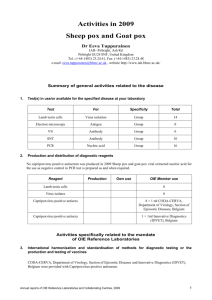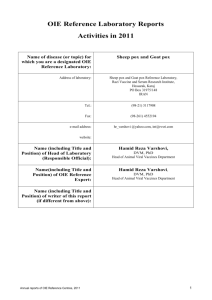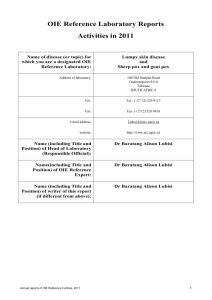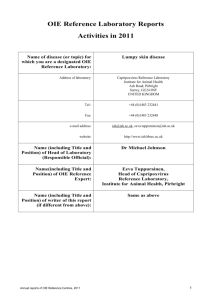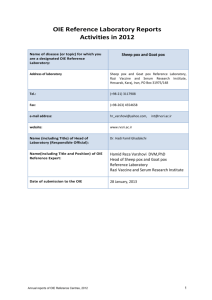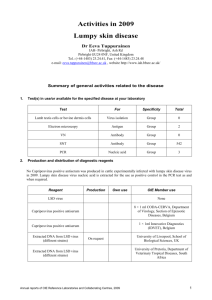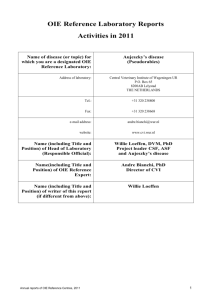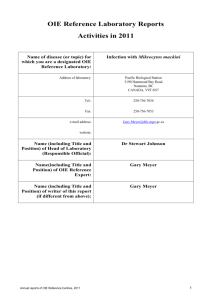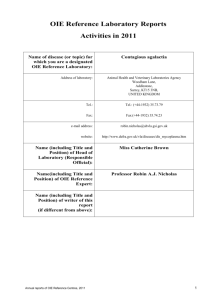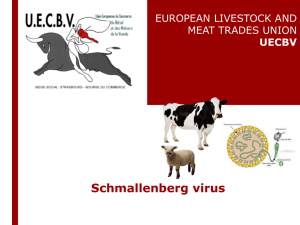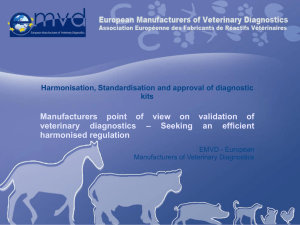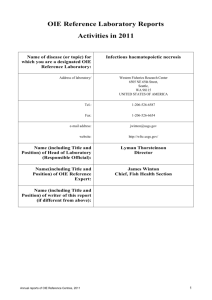Real-time PCR
advertisement
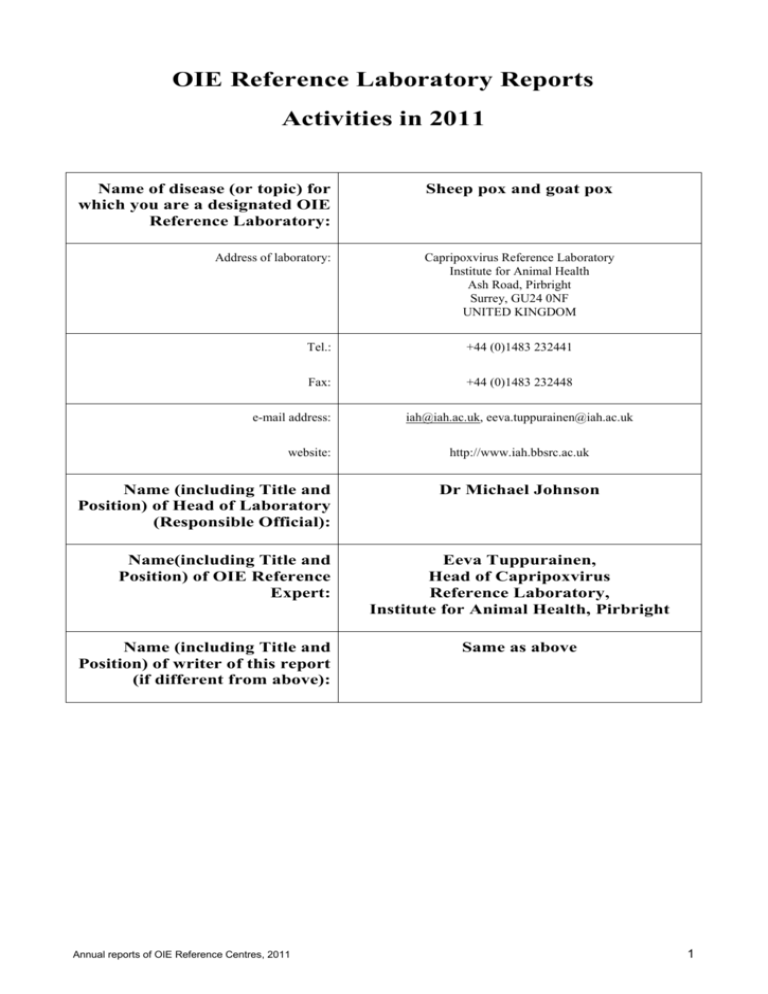
OIE Reference Laboratory Reports Activities in 2011 Name of disease (or topic) for which you are a designated OIE Reference Laboratory: Sheep pox and goat pox Address of laboratory: Capripoxvirus Reference Laboratory Institute for Animal Health Ash Road, Pirbright Surrey, GU24 0NF UNITED KINGDOM Tel.: +44 (0)1483 232441 Fax: +44 (0)1483 232448 e-mail address: website: Name (including Title and Position) of Head of Laboratory (Responsible Official): Name(including Title and Position) of OIE Reference Expert: Name (including Title and Position) of writer of this report (if different from above): Annual reports of OIE Reference Centres, 2011 iah@iah.ac.uk, eeva.tuppurainen@iah.ac.uk http://www.iah.bbsrc.ac.uk Dr Michael Johnson Eeva Tuppurainen, Head of Capripoxvirus Reference Laboratory, Institute for Animal Health, Pirbright Same as above 1 Sheep pox and Goat pox Part I: Summary of general activities related to the disease 1. Test(s) in use/or available for the specified disease/topic at your laboratory Test For Specificity Total Electron microscopy Antigen Group 0 SNT Antibody Group 26 VN Antibody Group Virus isolation on lamb testis and bovine dermis primary cell culture Antigen Antigen Gel-based PCR Group Antigen Real-time PCR 2. 13 Group 13 Production and distribution of diagnostic reagents Amount supplied nationally (including for own use) Amount supplied to other countries Control positive serum No pos antiserum production required during reporting period 35 ml Live virus 5 ml 1 x 1 ml in freeze dried form Extracted DNA from LSD virus (different strains) 2 ml 0 ml Type of reagent Part II: Activities specifically related to the mandate of OIE Reference Laboratories 3. International harmonisation and standardisation of methods for diagnostic testing or the production and testing of vaccines The following institutes were provided with method sheets for the diagnostic tests which are currently used at the Capripoxvirus Reference Laboratory at IAH for the detection capripoxvirus antigen or antibody: Animal Health Development Programme, Ministry of Agriculture, Irrigation and Livestock, CVDRL, Dar-ul-Aman, Kabul, Afganistan A previously published real-time PCR (Bowden et al., 2008) and a robotic extraction method were adapted to a highthroughput system and validated (Stage 2). The results were published in the Journal of Virological Methods (DOI 10.1016/j.jviromet.2011.11.015) a) Establishment and maintenance of a network with other OIE Reference Laboratories designated for the same pathogen or disease and organisation of regular inter-laboratory proficiency testing to ensure comparability of results A ring trial on the performance of serum neutralisation test was successfully carried out by the reference laboratories for sheep pox and goat pox at the Institute for Animal Health, UK and the Onderstepoort 2 Annual reports of OIE Reference Centres, 2011 Sheep pox and Goat pox Veterinary Institute (OVI), SA. We are continuing to strengthen our contact and improve harmonisation in testing between our reference laboratories. b) Organisation of inter-laboratory proficiency testing with laboratories other than OIE Reference Laboratories for the same pathogens and diseases to ensure equivalence of results No activity during the reporting period 4. Preparation and supply of international reference standards for diagnostic tests or vaccines No international standard reagents are available for capripoxviruses. The following institutes were provided with capripox-positive antiserum raised in experimentally infected cattle at the IAH, to be used as a positive control in serological tests for the detection of capripoxvirus antibodies: CODACERVA, Department of General Virology, Section of Epizootic Diseases, Belgium (5 ml) and Laboratoire de Production des Vaccins Antirabique et de la Clavelee, Institut Pasteur Algerie, 1, Rue du Caire Kouba, 16032 Algerie (5 ml). CSIRO Livestock Industries, Australia Animal Health Laboratory (AAHL), was provided with 410 x 50 µl capripoxvirus positive antiserum, comprising field samples and serum collected from experimentally infected and vaccinated animals (cattle, sheep and goats). These samples will be used for the development of a new ELISA for capripoxviruses OIE reference laboratory for LSD at the Onderstepoort Veterinary Institute (OIE), South Africa, was provided with LSD antiserum (a panel of 10 samples) to evaluate the serum neutralisation test (all capripoxviruses) for the quality control purposes and for the inter-laboratory test evaluation. The following institutes were provided with LSDV (Neethling strain) for the infection of experimental cattle and /or for the development/set up of diagnostic assays for capripox antigen or antibodies: CODA-CERVA, Department of General Virology, Section of Epizootic Diseases, Belgium (1 ml in freeze dried form). 5. Research and development of new procedures for diagnosis and control A previously published real-time PCR (Bowden et al., 2008) and a robotic extraction method were adapted to a highthroughput system and validated (Stage 2). The results were published in the Journal of Virological Methods (DOI 10.1016/j.jviromet.2011.11.015) The performance of a LAMP assay, recently developed at IAH for capripoxviruses, was evaluated using field and experimental samples and different capripox virus isolates. These isolates were previously tested at the capripox reference laboratory using both conventional and real-time PCR assays. A collaboration project entitled «Evaluation of a recombinant antigen ELISA for detection of antibodies against capripoxviruses» by the Capripoxvirus Reference Laboratory, IAH, the Roslin Institute, University of Edinburg, CSIRO Livestock Industries (CLI), Australian Animal Health Laboratory (AAHL) and Canadian Food Inspection Agency (CFIA) National Centre for Foreign Animal Disease (NCFAD) is on-going. A number of new antigens have been identified based on the capripoxvirus protein microarray data at CSIRO. Serum samples (410), comprising field samples and samples from vaccinated and experimentally infected animals (cattle, sheep and goats), held at the Capripoxvirus Reference Laboratory stocks, were sent to CSIRO, for the evaluation of new antigen candidates. 6. Collection, analysis and dissemination of epizootiological data relevant to international disease control No activities during this reporting period Annual reports of OIE Reference Centres, 2011 3 Sheep pox and Goat pox 7. Maintenance of a system of quality assurance, biosafety and biosecurity relevant to the pathogen and the disease concerned Capripoxvirus reference laboratory is accredited to ISO 9001, real-time PCR assay for capripoxviruses to ISO17025. 8. Provision of consultant expertise to OIE or to OIE Member Countries A twinning project is on-going with the National Animal Disease Diagnostics and Epidemiology Centre (NADDEC), Ministry of Agriculture Animal Industry and Fisheries, Entebbe, Uganda. Drs E. Tuppurainen and M. Henstock from IAH capripoxvirus reference laboratory visited Uganda 20-25th of June 2011. Conventional and real-time PCR methods for capripoxviruses were set up at NADDEC laboratory. The performance of these tests will be followed-up by testing of a panel of duplicate field samples in parent and candidate laboratories in early 2012 Upon request OIE member countries were advised on the availability of tests for the detection of capripoxvirus antigen or antibodies or provided with method sheets for setting up diagnostic methods. Sheep pox and goat pox data sheets were reviewed for CABI Animal Health and Production Compendium. 9. Provision of scientific and technical training to personnel from other OIE Member Countries The following institutes/countries sent participants to attend a training course at IAH Pirbright Laboratory, UK (3.05-13.05.11) entitled “Bluetongue, Peste des Petits Ruminants (PPR), and Capripox Diagnostics Course“: National Animal Disease Diagnostics and Epidemiology Centre (NADDEC), Entebbe, Uganda (2) and All-Russia Scientific Institute of Veterinary Virology and Microbiology, Pokrov, Russia (1). A twinning project with the National Animal Disease Diagnostics and Epidemiology Centre (NADDEC), Ministry of Agriculture Animal Industry and Fisheries, Entebbe, Uganda commenced on 1.11.2010. The project includes capripoxviruses with the aim to train the personnel and upgrade the diagnostic facilities in the Ugandan lab. Capripoxvirus presentation was included into the Notifiable and Exotic Disease Course which was organized for UK government veterinarians (30.06-1.07.11) by IAH. 10. Provision of diagnostic testing facilities to other OIE Member Countries NADDEC, Uganda sent 39 tissue and serum samples for confirmatory diagnostic testing 11. Organisation of international scientific meetings on behalf of OIE or other international bodies No activity during this reporting period 12. Participation in international scientific collaborative studies A collaboration project entitled «Evaluation of a recombinant antigen ELISA for detection of antibodies against capripoxviruses» by the Capripoxvirus Reference Laboratory, IAH, the Roslin Institute, University of Edinburg, CSIRO Livestock Industries (CLI), Australian Animal Health Laboratory (AAHL) and Canadian Food Inspection Agency (CFIA) National Centre for Foreign Animal Disease (NCFAD) is on-going. A number of new potential antigens for ELISA have been identified based on the capripoxvirus protein microarray data at CSIRO. 4 Annual reports of OIE Reference Centres, 2011 Sheep pox and Goat pox 13. Publication and dissemination of information relevant to the work of OIE (including list of scientific publications, internet publishing activities, presentations at international conferences) Presentations at international conferences and meetings No activity during the reporting period Scientific publications in peer-reviewed journals Lamien C. E., Le Goff C., Silber R., Wallace D. B., Gulyaz V., Tuppurainen E., Madani H., Caufour P., Adam T., Harrak M. E., Luckins A. G., Albina E., Diallo A. (2011). Use of the Capripoxvirus homologue of Vaccinia virus 30kDa RNA polymerase subunit (RPO30) gene as a novel diagnostic and genotyping target: Development of a classical PCR method to differentiate Goat poxvirus from Sheep poxvirus. Veterinary Microbiology, 149 (1-2), 30-39. Lamien C.E., Lelenta M., Goger W., Silber R., Tuppurainen E., Matijevic M., Luckins A.G. and Diallo A. (2011). Real time PCR method for simultaneous detection, quantitation and differentiation of Capripoxviruses, Journal of Virological Methods, 171 (1), 134-40. Stubbs S., Oura C.A.L., Henstock M., Bowden T.R., King D.P. and Tuppurainen E.S.M. (2011). Validation of a high-throughput real-time polymerase chain reaction assay for the detection of capripoxviral DNA. Journal of Virological Methods, in press, DOI 10.1016/j.jviromet.2011.11.015 Other communications Sheep pox/ goat pox data sheets were reviewed for CABI Animal Health and Production Compendium _______________ Annual reports of OIE Reference Centres, 2011 5
